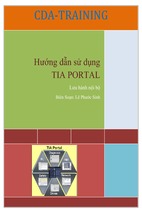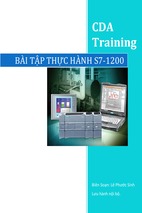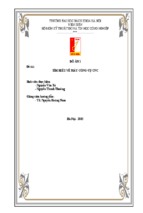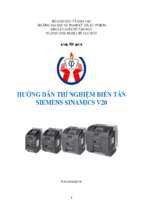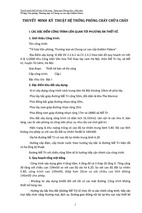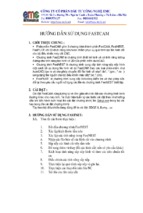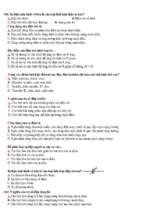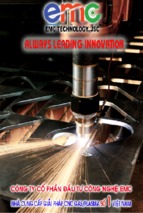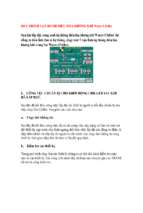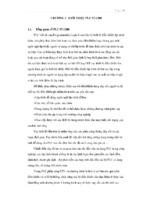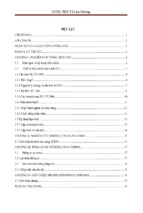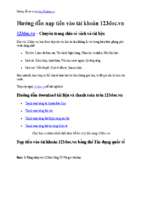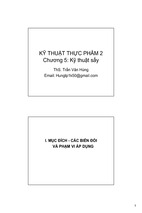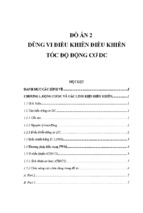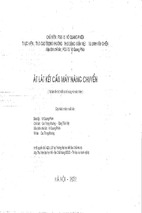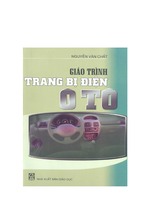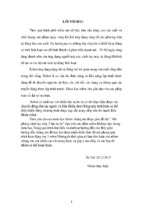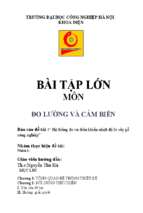Mô tả:
Activity and time categories
Work and Time Studies
Vietnamese German University
Dr.-Ing. Marlene Helfert
2016
Dr.-Ing. Marlene Helfert | Work and Time Studies | 2016 | 1
Activity and time types
Contents
Work system
Activity categories
Setting up and executing
Influenceability of work flows
Activity categories for the working person
Activity categories for the production facilities
Activity categories for the work piece
Time categories
Actual and standard times
Target times
Oder time
Occupation time
Dr.-Ing. Marlene Helfert | Work and Time Studies | 2016 | 2
Work system
Environment
Stress
Task
Result
Person
Person
Individual
Individual
characteristics
characteristics and
and
abilities
abilities
Tools
Strain
Feedback
Bubb 2014
Dr.-Ing. Marlene Helfert | Work and Time Studies | 2016 | 3
Work system
Elements of work systems
Relationships
System
System elements
Environment
Schlick et al. 2010
Dr.-Ing. Marlene Helfert | Work and Time Studies | 2016 | 4
Work system
Job order
Objective / purpose / goal
Input
Materials
Information
Energy
Working person(s)
Work
effect
task
Work equipment
Devices, tools
effect
Output
retroaction
retroaction
Work objects
Working materials
Results of
process
Quantity
Quality
Environmental influences
Social / organizational
| Physical / chemical
Schlick et al. 2010
Dr.-Ing. Marlene Helfert | Work and Time Studies | 2016 | 5
Work system
Schlick 2005
Dr.-Ing. Marlene Helfert | Work and Time Studies | 2016 | 6
Work system
Autonomous production cells as a work system
• Raw products
• Semi-finished products
• Clamping devices
• Production planning tasks
• Executing production tasks
• Inspection tasks for quality
assurance
• Interference management
• General maintenance tasks
Final product
Computer-aided
machine tools
• Fluctuation of order situation
• Varying quality of raw resp. semi-finished products
• Temporally changing states of machines and tools
Schlick 2005
Setting of key values for production
control:
• Quantity structures
• Capacity utilizations
• Arranged deadlines
Skilled workers with
complete scope of tasks
(planning, executing,
controlling)
Dr.-Ing. Marlene Helfert | Work and Time Studies | 2016 | 7
Work system
Exercise
Sketch a simple work system of you typing an email.
Dr.-Ing. Marlene Helfert | Work and Time Studies | 2016 | 8
Work system
© Jan Dul, Keynote at IEA 2012 Recife, Brazil 15/02/2012
Dr.-Ing. Marlene Helfert | Work and Time Studies | 2016 | 9
Work system
© Jan Dul, Keynote at IEA 2012
Recife, Brazil 15/02/2012
Dr.-Ing. Marlene Helfert | Work and Time Studies | 2016 | 10
Work system
© Jan Dul, Keynote at IEA 2012 Recife, Brazil 15/02/2012
Dr.-Ing. Marlene Helfert | Work and Time Studies | 2016 | 11
Work system
Customer service
in Europe
Designed
in USA
Made
in China
© Jan Dul, Keynote at IEA 2012 Recife, Brazil 15/02/2012
Dr.-Ing. Marlene Helfert | Work and Time Studies | 2016 | 12
Work system
Structure
Environment
Achieved
goal
Defined
goal
Workspace O1
Management system
Person
Person
Executive information system
Work
result
Work
task
Execution system
Person
Person
Work equipment
Workspace O2
Work object
Disturbance
Schlick et al. 2010
Dr.-Ing. Marlene Helfert | Work and Time Studies | 2016 | 13
Work system
Basic qualities, forms of work
Basic quantities
Working people: AP={M1, M2, ...}
Work equipment: AM={AM1, AM2, ...}
Work object: AO={AO1, AO2, ...}
Workspace: O={O1,O2, ...}
Forms of work
Individual work: |AP|=1
Cooperative work: |AP|>1
Distributed work: O1 ∩ O2 = Ø
Spatial association: O1 ∩ O2 ≠ Ø
Self-control(also self-regulation): M1=M2
External control: M1≠M2
Work classification system
• Non-material work system (service system): m=m‘
• Material work system (production system): m≠m‘
• Mechanized work system: If E2 contains technologically produced energy forms
• Automated work system: If I1 or I2 contains technically produced information
Schlick et al. 2010
Dr.-Ing. Marlene Helfert | Work and Time Studies | 2016 | 14
Work system
Economic evaluation
Effectiveness: „doing the right things“
vs.
Efficiency: „doing things right“
Economic evaluation
Value-added labor system:
value(output) > value(input)
Value-neutral labor system(ex. Transport):
value(output) = value(input)
Value-lost labor system(ex. Rejections):
value(output) < value(input)
Effective labor system:
(defined goal – achieved goal)2 < ɛ2
(ɛ: Target range for time, cost, quality, etc.)
Ineffective labor system:
(defined goal – achieved goal)2 > ɛ2
Efficient labor system:
(defined goal – achieved goal)2 < ɛ2 ^
value(input) min
Inefficient labor system:
(defined goal – achieved goal)2 < ɛ2 ^
value(input) is not minimal
Schlick et al. 2010
Dr.-Ing. Marlene Helfert | Work and Time Studies | 2016 | 15
Activity categories
Purpose
For the recording and assessment of the occurrences in the
work system, the work process of the whole system as well as
of the system elements working person, production facilities,
and workpiece is broken down into activity categories and
analyzed. These categories are a base for several analysis, e.g.
Set-up time minimization
Determination of optimization potentials
Increase of values creation
Determination and reduction of unplanned activities
Multiple machine operation
REFA 2013
Dr.-Ing. Marlene Helfert | Work and Time Studies | 2016 | 16
Set up and execution
On duty
Set up
R
Execute
A
Setting-up is the preparation of the work system
for fulfilling the work task and (if needed) the
reinstatement of the work system in the original
state, e.g. read drawing, get and bring back tools,
set up machine, etc.
REFA 1997
Dr.-Ing. Marlene Helfert | Work and Time Studies | 2016 | 17
Influenceability of workflows
In uninfluenceable
processes the processing
time can not be influenced
by the worker, if he
complies to the given
working methods.
In fully influenceable
processes the processing
time does only depend on
the worker.
Uninfluenceable
Activity
MT
Fully influenceable
Influenceable
Conditionally
influenceable
In conditionally influenceable processes the
processing time can only be influenced by
the worker up to that level of leeway that
the given working methods offer.
REFA 1997
Dr.-Ing. Marlene Helfert | Work and Time Studies | 2016 | 18
Influenceability of workflows
Examples
Fully influenceable
Mount parts
Change wheel
Read drawings
Conditionally
influenceable
Uninfluenceable
Braze
Weld
Drive a car
Check bottles on a
conveyer
Supervise
instruments on a
control desk
Automatized
conveyer belt
Process fully
controlled by
machines
REFA 1997
Dr.-Ing. Marlene Helfert | Work and Time Studies | 2016 | 19
Activity categories
Types of activity categories
When production procedures and processes are classified
according to …
the working person, the activities of one employee within a
specific time period are analyzed
the production facilities, the status of the machines,
equipment etc. is regarded
the product or work piece, which is manufactured, the
production cycle of an assembly or product is analyzed
If needed, also a categorization of the information flow is
possible.
Schlick 2005
REFA 2013
Dr.-Ing. Marlene Helfert | Work and Time Studies | 2016 | 20
- Xem thêm -

